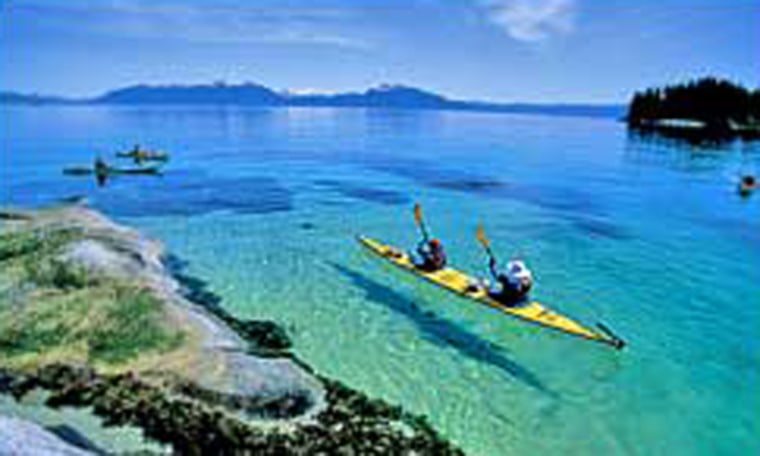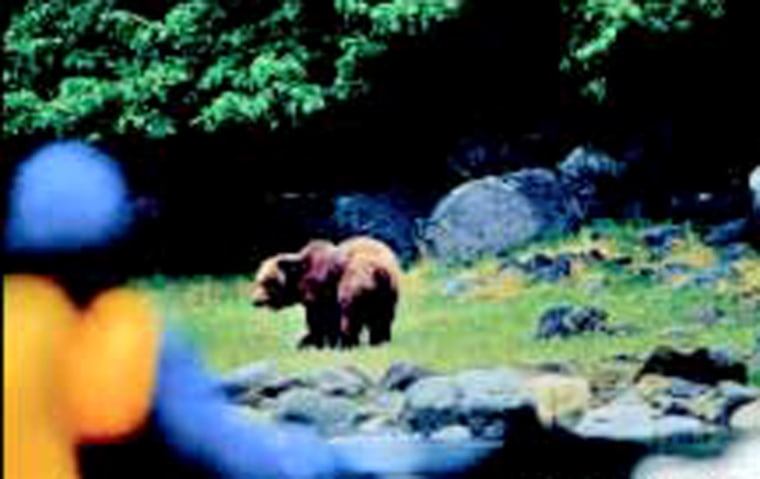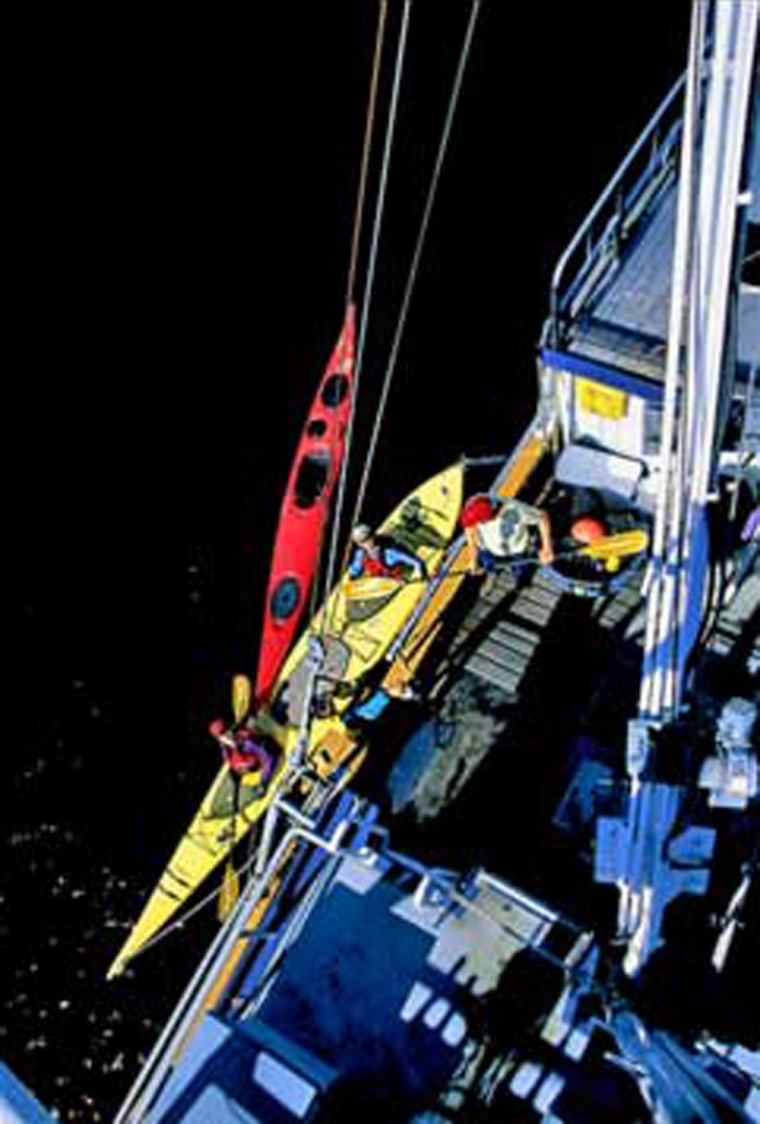We had been paddling for hours in a cold, penetrating Alaskan drizzle. Our five kayaks—three tandems and two singles—were widely spaced, with the most distant ones blurred intermittently by fog. Onshore, nothing remotely resembled a decent campsite. Dense rain forest extended right down to the waterline, and seaweed raked from the last high tide was draped from the lowest branches like toilet paper left behind by Halloween pranksters. Beneath, a steep, rocky shore provided few places to land a kayak, much less to pitch a tent. It was starting to get late, about 9:30 p.m. Even though we were at 57 degrees north latitude just one week before the summer solstice, there was little more than an hour of daylight remaining. The sprinkles turned to steady rain.
Rounding a point, we spied the only beach we’d seen all day, on the far shore across Kasnyku Bay. Paddling directly toward it, we soon noticed the unmistakable blue smudge of wood smoke as we got closer. Then, a couple of kayaks and tents materialized out of the murk on the tiny pocket of sand. These were the only other paddlers we would encounter during the entire upcoming week, and they occupied the only campsite we had seen on this, our first day of kayaking around Baranof Island.
They looked like a dispirited crew, a group of wet hens in green slickers. Huddled around their weak campfire, they didn’t exactly resemble a welcoming committee. Before paddling within speaking distance, we steered away and pulled into a dank, compact cove. My wife, Laura, remarked, “What a miserable night for camping.”
Fortunately for us, it didn’t matter. Minutes later, our mother ship, the Home Shore, puttered into the cove for our prearranged rendezvous. We paddled alongside and climbed aboard; skipper Jim Kyle hoisted our kayaks up behind us with his boat’s boom.

As we changed into warm, dry clothes, Jim and his son, Ben, retrieved shrimp traps set earlier in the outer bay. They were somewhat disappointed with the harvest—a dozen or so from the first trap, only a handful in the next, a couple of dozen more in the last. Still, a bucket was sufficiently filled with the wriggly pink crustaceans that they kept springing out onto the slippery deck in futile attempts to escape through the scupper holes. Ben scampered to retrieve them, but we would have to wait until breakfast to enjoy them, served in the form of shrimp and avocado omelets. Meanwhile, we had a dinner of king salmon and fettuccine to dispatch, along with a couple of bottles of wine and a plate of fresh-baked chocolate-chip cookies.
As we motored farther down Chatham Strait toward our anchorage for the night, the camped kayakers slowly dissolved in the distance off our stern. I couldn’t help but think about how many nights I had spent in similar circumstances—pitching a tent in the rain, tracking wet sand inside, fumbling with a mound of soaked clothes, preparing an uninviting meal, trying to keep my spirits up even when it continued to rain for hours and sometimes days on end. Instead, I was getting my first taste of kayaking in relative luxury.
Perhaps no other place is better suited to the mother-ship concept than Alaska. To begin with, there’s a lot of distance to cover—far more than anyone can hope to paddle in a lifetime. A circumnavigation of Baranof Island is more than 200 nautical miles and would take several weeks by kayak. We went around it in seven days aboard the Home Shore, cherry-picking the best places to paddle along the way—deep fjords, secluded bays, ragged islands, and wave-battered sea stacks.
A mother ship also makes it possible to avoid pesky Alaskan critters both large and small. Camping in brown bear country can be intimidating and requires scrupulous food management and care while cooking. We saw only two bears, each grazing in knee-high beach grass, but it was a lot more comfortable watching them from the deck of the Home Shore than peering anxiously through the door of a tent pitched on the same cramped beach. Then there are those smaller Alaskan carnivores to contend with—biting bugs. On our trip, we never used head nets or insect repellent. We spent most of our time beyond the range of mosquitoes, flies, and midges, whether paddling kayaks or cruising aboard our mother ship. When you’re anchored half a mile offshore, they’re not much of a problem, and it’s a real joy to no-see-um.

What we did see was lots of wildlife. Bald eagles were as routine as gulls, puffins as common as crows. Rounding the island’s southern point, Cape Ommaney, we smelled a large group of Steller sea lions basking on the wave-washed rocks before we actually spotted them. Minutes later we were drifting in the tidal current, surrounded by 30 to 40 humpback whales, alternately rolling on the surface and diving beneath it, momentarily holding their enormous tail flukes aloft before slipping noiselessly into the sea. Later, while paddling in swells amid an outer-coast rock garden, we inadvertently came upon a sea otter nursery, where a large raft of mother otters glided effortlessly on their backs while clutching their fuzz-ball pups on their chests.
But there’s no denying it. Besides the wildlife-viewing potential, one of the best things about kayaking from a mother ship is comfort. As indicated earlier, Alaska can be wet and cold. Paddling in the rain is no big deal, but it can be a drag to camp in it night after night. On one kayak trip to Glacier Bay, Laura and I aborted a day early simply because we grew tired of the continuously soggy conditions. On a mother ship, not only is it cozy and dry, but there are also a host of other little luxuries: soft bunks instead of hard ground, tasty meals instead of reconstituted glob, flush toilets instead of cat holes, and a hot shower instead of stinky polypro.
On the last morning of our circumnavigation, the Home Shore’s engine gurgled to life around 4 a.m. I swayed gently in my bunk as the anchor clanked while being weighed. The thought of drifting back to sleep was appealing, but the sun was already peeking around the porthole curtain next to my face and I loathed the thought of missing anything. Hoping to see another bear, I scoured the shoreline with my binoculars from the aft deck, but gave up as we pulled farther away. I grabbed a cup of coffee in the galley and climbed up to the pilothouse to join the skipper. “Mornin’ Ross,” Jim said, while slowly opening the throttle after passing the last shoals between us and the open waters of Sitka Sound.
Beneath a tangerine sky, we motored into a Japanese landscape painting. On the horizon rose Mount Edgecumbe, a perfect pastel pyramid. Near the dormant volcano’s base was a faint watercolor spot—St. Lazaria Island—the destination for our last paddle. Jim dropped anchor and cut the engine when we arrived in the small island’s lee more than an hour later. The squawks and cries of shorebirds filled the air. Rhinoceros auklets skimmed inches above the sea, while tufted puffins flew so close overhead I was certain that one would hit the boat’s rigging. The vertical dark cliffs of St. Lazaria were crowded with thousands of pigeon guillemots and common murres.

The rest of our crew had risen, and soon all kayaks were launched. We craned our necks to watch the puffins dive-bomb into their island burrows overhead, then paddled into a dark sea cave on gentle swells. Lazily we paddled around the island, through confused reflective waves on the outside, before returning to our starting point in time for breakfast.
Some mother ships offer yachtlike luxury, but one of the things I liked most about the Home Shore is that she’s a working boat, a seiner, with a long and proud history in Alaskan waters. Built in 1944, she is just one year older than her skipper. True to the boat’s heritage, we enjoyed several meals of freshly caught king salmon. Even better, at the end of the season, when kayak tourists like me and the other guests pack up and head south, the cushy staterooms on the boat’s aft deck can be lifted off, converting the Home Shore back to what she knows best—fishing.
is the number one paddlesports resource, with a wealth of information about canoeing and kayaking destinations, gear, and techniques.
